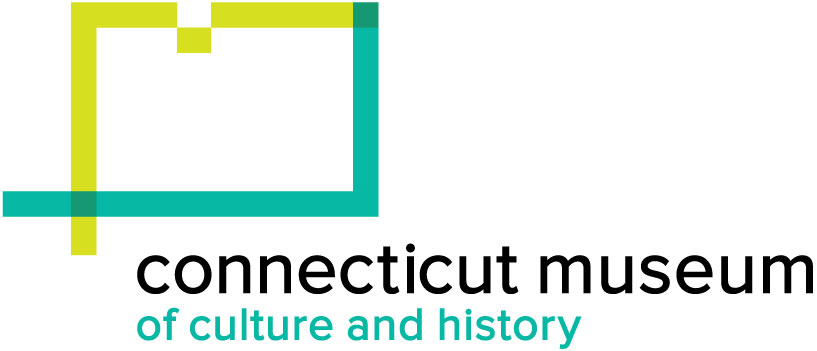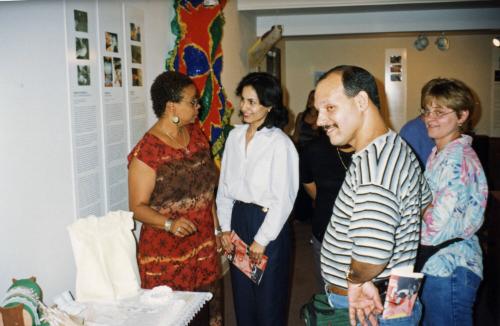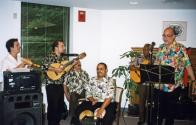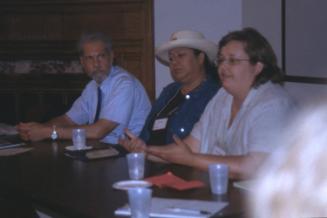Exhibition Opening: Mano a Mano: Puerto Rican Traditional Art From Island to City
SubjectPortrait of
Glaisma Pérez Silva
(Puerto Rican)
SubjectPortrait of
Graciela Quiñones-Rodriguez
(Puerto Rican)
SubjectPortrait of
Alfred Rivera
(Puerto Rican)
SubjectPortrait of
Gryssel Ramirez
(Puerto Rican)
SubjectPortrait of
Lynne Williamson
DateJuly 1999
MediumPhotographs
ClassificationsGraphics
Credit LineConnecticut Cultural Heritage Arts Program collections
CopyrightIn Copyright
Object number2015.196.333.1-.26
DescriptionPhotographs of the exhibition opening of "Mano a Mano: Puerto Rican Traditional Art From Island to City" held in July 1999.
(.1) Glaisma Perez Silva, advisory team member, is talking to exhibit viewers including Carmen Sierra, at the event.
(.2) A Puerto Rican community member is viewing the carved rooster.
(.3) Glaisma Perez Silva, advisory team member, is talking to exhibit viewers including Carmen Sierra, at the event.
(.4-.5) Crafts displayed in the exhibit including baskets, model houses, and a book with the Puerto Rican flag as its cover.
(.6) The woven cattails section of the exhibition.
(.7) ICR intern Kari Stanek (left) and ICR youth coordinator Monica Brase (right).
(.8) Puerto Rican community member Isidonio Morales viewing the exhibit.
(.9) Puerto Rican community members viewing the exhibit.
(.10) Project advisory team members Graciela Quinones-Rodriguez (left) and Glaisma Perez Silva (right).
(.11) A fruit carving created for the opening reception.
(.12) Puerto Rican community member Isidonio Morales viewing the exhibit.
(.13) Daniel Roman, "Cuco" - guitarist in the music group Amor y Cultura who performed at the event.
(.14) ICR staff at the exhibit opening event. Pictured left to right are Rocio Chang, unknown, and Juan Restrepo.
(.15) ICR Director Jean Schensul speaking at the opening event.
(.16) Then CCHAP Director Lynne Williamson speaking at the opening event.
(.17) A musical performance by singer Felix Delgado with Amor y Cultura at the opening event.
(.18) Project advisory committee member Glaisma Perez Silva with guests listening to music.
(.19-.20) Panya Rozie and her daughter dancing at the opening event.
(.21) A music performance by Alfred Rivera and Gryssel Ramirez with Amor y Cultura performing at the opening event.
(.22) Attendees at the opening event. Pictured left to right are Lynne Williamson, Marlene Berg, Gryssel Ramirez, and an unidentified person.
(.23-.24) A musical performance by Amor y Cultura, featuring musicians Gryssel Ramirez, Alfred Rivera, Ramon Arroyo, Alfredo Gonzalez, Daniel Roman, and Felix Delgado.
(.25) Puerto Rican community members viewing the exhibit.
(.26) Don Carmelo’s wire net masks displayed in the exhibit.
NotesSubject Note: A locally-based team of Puerto Rican artists, in collaboration with CCHAP at the Institute for Community Research, Guakia, and the Crafts Development Office of Puerto Rico's Economic Development Department (PRIDCO), worked together to bring a multi-faceted program of Puerto Rican traditional arts to Hartford during the summer of 1999. "Mano a Mano: Puerto Rican Traditional Arts from Island to City," began with the July 1, 1999, opening at the ICR gallery of an exhibition of fourteen craft forms practiced in Puerto Rico. Later in the summer, five master traditional artists traveled from Puerto Rico to offer week-long workshops in their craft forms to the public. After the workshops ended, participants who wanted to continue working with their crafts were mentored by the local artists on the project team.(.1) Glaisma Perez Silva, advisory team member, is talking to exhibit viewers including Carmen Sierra, at the event.
(.2) A Puerto Rican community member is viewing the carved rooster.
(.3) Glaisma Perez Silva, advisory team member, is talking to exhibit viewers including Carmen Sierra, at the event.
(.4-.5) Crafts displayed in the exhibit including baskets, model houses, and a book with the Puerto Rican flag as its cover.
(.6) The woven cattails section of the exhibition.
(.7) ICR intern Kari Stanek (left) and ICR youth coordinator Monica Brase (right).
(.8) Puerto Rican community member Isidonio Morales viewing the exhibit.
(.9) Puerto Rican community members viewing the exhibit.
(.10) Project advisory team members Graciela Quinones-Rodriguez (left) and Glaisma Perez Silva (right).
(.11) A fruit carving created for the opening reception.
(.12) Puerto Rican community member Isidonio Morales viewing the exhibit.
(.13) Daniel Roman, "Cuco" - guitarist in the music group Amor y Cultura who performed at the event.
(.14) ICR staff at the exhibit opening event. Pictured left to right are Rocio Chang, unknown, and Juan Restrepo.
(.15) ICR Director Jean Schensul speaking at the opening event.
(.16) Then CCHAP Director Lynne Williamson speaking at the opening event.
(.17) A musical performance by singer Felix Delgado with Amor y Cultura at the opening event.
(.18) Project advisory committee member Glaisma Perez Silva with guests listening to music.
(.19-.20) Panya Rozie and her daughter dancing at the opening event.
(.21) A music performance by Alfred Rivera and Gryssel Ramirez with Amor y Cultura performing at the opening event.
(.22) Attendees at the opening event. Pictured left to right are Lynne Williamson, Marlene Berg, Gryssel Ramirez, and an unidentified person.
(.23-.24) A musical performance by Amor y Cultura, featuring musicians Gryssel Ramirez, Alfred Rivera, Ramon Arroyo, Alfredo Gonzalez, Daniel Roman, and Felix Delgado.
(.25) Puerto Rican community members viewing the exhibit.
(.26) Don Carmelo’s wire net masks displayed in the exhibit.
This project was funded by the Lila Wallace Readers Digest Fund Community Folklife Program, the Roberts Foundation, the Greater Hartford Arts Council, the National Endowment for the Arts, the CT Commission on the Arts, PRIDCO, and the Institute for Community Research
Members of the project team were Melanio J. González, Pavlova Mezquida (PRIDCO), Glaisma Pérez-Silva, Graciela Quiñones-Rodríguez, Marcelina Sierra, Victor M. Sterling, and Lynne Williamson. Because of the knowledge and time needed to locate and purchase appropriate materials for the five workshops, ICR hired a local Puerto Rican artist, luthier Graciela Quinones Rodriguez, to help coordinate this important aspect as well as recruitment of workshop participants.
The project furthered many goals important to the team, including promoting awareness of the contributions of Puerto Rican artists, increasing access within the Puerto Rican community to training in art and entrepreneurial skills, and encouraging relationships across generations. The traditional arts and crafts of Puerto Rico remain vibrant and beloved, both on the island and in the new places where Puerto Rican people have settled. The project celebrated the strong cultural traditions remembered and practiced by so many in Hartford's large Puerto Rican community. Artistic, social, and cultural practices within Connecticut Puerto Rican communities show a regular and active maintenance of familiar traditions which link urban Puerto Ricans to the island, to which many return for visits. The primary goal of the project was to reinforce these patterns of cultural practice and remembrance. Other goals included: 1. To address the need for more public programming and education in Puerto Rican cultural expressions, both for members of this community and for general audiences; 2. To reinvigorate local Puerto Rican artists by connecting them with master traditional artists from the island who rarely visit the mainland; 3. To help preserve knowledge and practice of Puerto Rican traditional art forms; 4. To provide training and support for local artists who wish to begin or continue to develop an economic base for their artistic productions.
The exhibition drew from the work of master artists and their apprentices who participated in PRIDCO's Traditional Arts Apprenticeship Project. Through the Crafts Development Office of the Puerto Rico Industrial Development Company (PRIDCO), Puerto Rico hosts an island-wide training program in traditional arts. Law 166, first passed in 1986, mandates that five government agencies in Puerto Rico provide services to artisans for their education and for the marketing and promotion of their work. This enlightened policy recognizes that traditional arts contain great cultural value because they express the collective wisdom and the soul of a community of people. Traditional arts also represent a vital link to the past, as they are transmitted from one generation to the next through long-term, informal, one-on-one teaching between a master artist and a student. Learning an artistic form through the process of apprenticeship is a powerful way to pass on cultural knowledge as well as the craft itself; this process also helps to develop relationships across generations.
On display from July 1 - October 1999, the exhibit was designed and installed by the same team which produced ICR's successful Herencia Taína exhibit in 1997. PRIDCO loaned art works from its Traditional Arts Apprenticeship project, featuring 16 important craft traditions practiced in Puerto Rico today. Traditions featured included: Marímbolas/Percussion Instruments; Panderos/Plena Tambourines; Volantines/Kites; Vejigantes/Coconut Masks; Hatillo Mascaras/Wire Net Masks; Artesanía en Lata/Tin Crafts; Talla de Gallos/Carved Roosters; Alfarería Tradicional/Indigenous Pottery; Encuadernación/Bookbinding; Papel Maché/Papier Maché; Talla de Santos/Saint Carvings; Estampas Típicas/Folk Houses; Tejido de Bejuco/Liana Weaving; Tejido de Enea/Cattail Weaving; Mueble de Mundillo/Lace Cushion and Holder; Bolillos/Bobbins; Mundillo/Lace.
Based on fieldwork in the Hartford community, ICR and Guakia added examples from local artists working in similar traditions. Based on research done by the PRIDCO's crafts apprenticeship project, Lynne Williamson edited, with PRIDCO and Hartford members of the project team, extensive bilingual labels explaining the art forms. The signage was produced by the Peabody Museum in New Haven. At the opening, which was a Greater Hartford Arts Council First Thursday event, the local cuatro group Amor y Cultura performed.
Puerto-Rican based artists giving workshops were: Angel del Valle - pandero making and playing; Amelia Fonseca - the art of cake decoration; Vicente Valentín - cuatro building; América Nieves - mundillo lace making; and Alice Chéverez teaching indigenous pottery making. Workshops took place at ICR and at locations in the Puerto Rican community. The trainings were free with some materials costs paid by participants; workshops were bilingual. The weeklong workshops were intensive apprenticeship sessions designed for local artists who already had a level of skill in the tradition being taught or a closely related art form. The purpose is to develop further the skills of artists committed to a tradition so that they will be able to pass it on and perhaps market their work. The last day of each workshop was open to the public. The two music-oriented workshops (cuatro and pandero-making) celebrated with impromptu concerts by participants. Artworks by the teaching artists were displayed in the exhibit.
Two follow-up mentorships were conducted by local traditional artists – Ana Lozada in cake decorating and Mel Gonzalez in clay art work. They met regularly with workshop participants, encouraging them to continue producing, offering further training in techniques of the art form if necessary, and advising on marketing procedures and outlets.
An unexpected benefit from the workshops was the degree of interaction between the participants, many of whom did not know each other before. CCHAP noticed that while they were engaged in the art forms, participants talked openly about their lives and issues important to them. Such workshops could be a useful setting for social or other research projects because people feel relaxed and informal (and in fact this outcome stimulated the development of CCHAP’s Sewing Circle Project in 2007). During the last session colleagues from Centro Civico, an arts and social service organization in Amsterdam, New York visited the project and became very interested in the potential for arts workshops to enhance communication and information gathering. Also, two of the workshops were held at La Casa Elderly Housing on Park Street, where the seniors showed a great interest in the art activities.
Proportionate to its size, Connecticut has one of the largest Puerto Rican populations on the mainland, especially in the major urban areas of Bridgeport, New Haven, Hartford, and Waterbury. People arrived from the island in great numbers after World War II to work in both factories and fields, especially eastern Connecticut's tobacco farms. Puerto Ricans in Connecticut are characterized by their migration patterns - they generally don't consider themselves "immigrants" or "settlers" in the state; they came here for work and continue to live here but frequently travel back to the island which they often view as a paradise, a homeland to which they belong and will return. Their nostalgia for the island is undoubtedly heightened by the difficult conditions many Puerto Ricans experience here, especially in cities: considerable prejudice, urban violence, poor schools, as well as high prices and taxes. An often-mentioned statistic compares Connecticut's per capita income, which is the highest in the nation, with its responsibility for four of the country's poorest cities - those listed above. Although large, the Puerto Rican community here is seriously underserved by local cultural, educational, and social organizations.
The community's love for the island and its culture has enhanced Connecticut's cities, especially Hartford, the location of this project's activities. Latinos, primarily Puerto Ricans, make up 35% of Hartford's population. The heart of the community is Park Street, the main thoroughfare in the Puerto Rican neighborhood known as Frog Hollow. Botanicas, bakeries, music clubs, bodegas, and restaurants named for Puerto Rican towns make this a vibrant center of constant activity. Artistic, social, and cultural practices within the community show a regular and active maintenance of beloved traditions which link urban Puerto Ricans to the island, and many return regularly for visits. The primary goal of this project was to reinforce the patterns of cultural practice and remembrance.
Biographical Note: Glaisma Pérez Silva is a Puerto Rican educator, professor, and Spanish-language poet who held teaching and administrative positions in the Hartford area from 1988 and now in Massachusetts. She holds a masters degree from the InterAmerican University of Puerto Rico and has received certificates of study and awards from several organizations. She is the founder of Coloquio, a poetry reading group for Latino writers in Spanish, and has been published in a number of anthologies. She produced and hosted the weekly radio program De Mujer a Mujer con Glaisma Pérez Silva on WRYM 840 AM, and a Spanish-language program broadcast on WFCR in Amherst, Massachusetts. Glaisma has been selected as a Master Teaching Artist by the Connecticut Commission on the Arts. She presented her poetry at many events, including some organized by CCHAP, in Hartford and around New England. A dynamic presenter, she often incorporates music into her poetry events.
Biographical Note: “Isidonio Morales, 73, of East Hartford, beloved husband of 54 years to Julia Morales, passed away Thursday (May 20, 2010). He was born in Humacao, Puerto Rico and later migrated to Hartford, CT. He was a successful young entrepreneur and socially active in his Puerto Rican community. He was one of the Founding Fathers of the Puerto Rican Business Association (PRBA) which is presently known as SAMA (Spanish-American Merchant's Association). He also helped coordinate the 1st Puerto Rican Parade in Hartford. Among his successful businesses were Morales Record Shop, the Lenox Theater (the first Spanish theater in Hartford), La Bana San Juan (one of the first Puerto Rican clubs in Hartford), and other radio, record and clothing businesses. He also served as Justice of the Peace for over 15 years in Hartford. To his friends and associates, he was known as "El Cura" and "El Padre". Most importantly, he was a beloved husband, father, brother, and uncle. He is survived by his six children: Samuel of East Hartford; Rachel Vargas of West Hartford; Celedonio (Cano) of New Britain; Gary of Hartford; Julia Elena Morales of New Britain; and Carmen Delia Perez of New Britain. He is also survived by 12 grandchildren and six great-grandchildren. Relatives and friends are welcome to join the family on Thursday (May 27, 2010), between the hours of 6-9 p.m. at the DeLeon Funeral Home located on 104 Main Street, Hartford, Connecticut. A funeral procession will gather at 9 a.m. on Friday (May 28, 2010), at the DeLeon Funeral Home and burial will follow at Mount Saint Benedict Cemetery. In lieu of flowers, donations will be accepted and can be made out to Rachel Vargas.” Published by Hartford Courant on May 26, 2010.
Subject Note: Amor y Cultura is a five-seven member musical group from Connecticut specializing in musica jibara, the folk music of Puerto Rico’s interior mountain regions. The group also performs plena and popular Latin dance styles such as salsa and merengue.
Amor y Cultura’s roots and heart lie with música jibara and its signature instrument, the cuatro. Several members of the group began their folk music experiences in Puerto Rico. The oldest member, Florentino Rivera, sang the rosary as a child - when someone died, he would be called to sing at the wake. His son, Alfred Rivera, took up the guitar and cuatro at a young age, when he would accompany his father at Christmas parrandas. Joe Diaz from Morovis has played Puerto Rican stringed instruments for twenty-eight years, and has accompanied the great cuatrista Nieves Quintero. Singer and drummer Milton Rosado from Maricao specializes in the bolero song form.
The catalyst which brought Puerto Rican musicians together in Connecticut was a unique música jibara school started by master cuatrista Virgilio Cruz in the early 1990's. Several evenings each week after work, people would gather in Hartford’s Puerto Rican neighborhood to take classes in cuatro playing, traditional musical forms such as the seis and aguinaldo, and folk singing taught by Mr. Cruz and others skilled in those traditions. More than just a learning experience, the school brought many people together around the common social bond of música jibara at a time when Hartford offered few cultural activities for Latinos. The school gave rise to La Primera Orquesta de Cuatros, a large performing group of cuatristas and singers which would hold regular concerts in local churches and halls. Amor y Cultura members Alfred Rivera and Joe Diaz performed in the Orquesta and also in Canto Isleño, the school’s select performing group. Ramon Arroyo, a singer who sometimes performs with Amor y Cultura, competed as a trovador in the school’s annual Concurso, a traditional competition for oral composition of the décima song form.
The school ended after Virgilio Cruz returned to Puerto Rico, but many musicians who had been trained there continue to play regularly at venues such as Peter’s Café, Los Hermanos, and La Comerio on Park Street in Hartford, and the Puerto Rican Society in New Britain. Amor y Cultura grew out of these gatherings, forming as a group in 1994. They played at parrandas, festivals, local Spanish restaurants, and musical masses at churches. The group was invited to play on Pedro Garcia’s folk music radio show on WRYM, the original Spanish-language show in Hartford. Other performances have been at the National Society of Hispanic MBAs Annual Awards Ceremony, “Main Street USA” in New Britain, the Puerto Rican Parade in Hartford, a benefit concert for the monument to the Hispanic family, with recording artists Antonio Caban Vale “El Topo” and Lucecita Benitez, and on the nationally televised show “Desde Mi Pueblo” broadcast live from Park Street. In 1997, they made their first recording. Amor y Cultura participates in a vibrant Puerto Rican musical scene throughout Connecticut.
Additional material related to this exhibition is in the CCHAP archive.
Cataloging Note: This project was made possible in part by the Institute of Museum and Library Services MA-245929-OMS-20.
Status
Not on viewIlka Robles
July-September 2003
Ilka Robles
June-August 2003
Ramón Arroyo
2002 August 7; ca. 1997






































